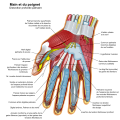File:Wrist and hand deeper palmar dissection-numbers.svg
外觀

此 SVG 檔案的 PNG 預覽的大小:474 × 600 像素。 其他解析度:190 × 240 像素 | 379 × 480 像素 | 607 × 768 像素 | 809 × 1,024 像素 | 1,619 × 2,048 像素 | 555 × 702 像素。
原始檔案 (SVG 檔案,表面大小:555 × 702 像素,檔案大小:207 KB)
檔案歷史
點選日期/時間以檢視該時間的檔案版本。
| 日期/時間 | 縮圖 | 尺寸 | 用戶 | 備註 | |
|---|---|---|---|---|---|
| 目前 | 2015年6月1日 (一) 17:15 |  | 555 × 702(207 KB) | Perhelion | optimize image |
| 2012年7月8日 (日) 11:42 |  | 555 × 702(399 KB) | Wilfredor | optimize image | |
| 2009年1月13日 (二) 21:11 |  | 555 × 702(817 KB) | Wilfredor | {{Information |Description= |Source= |Date= |Author= |Permission= |other_versions= }} | |
| 2008年10月16日 (四) 16:37 |  | 555 × 702(815 KB) | Wilfredor | {{Information |Description= |Source= |Date= |Author= |Permission= |other_versions= }} | |
| 2008年7月23日 (三) 19:33 |  | 770 × 767(822 KB) | Bibi Saint-Pol | {{Created with Inkscape}} == {{int:filedesc}} == {{Information |Description= {{en|The hands (med./lat.: manus, pl. manūs) are the two intricate, prehensile, multi-fingered body parts normally located at the end of each arm of a human or other primate. Th |
檔案用途
下列3個頁面有用到此檔案:
全域檔案使用狀況
以下其他 wiki 使用了這個檔案:
- af.wikipedia.org 的使用狀況
- ar.wikipedia.org 的使用狀況
- az.wikipedia.org 的使用狀況
- bew.wikipedia.org 的使用狀況
- bjn.wikipedia.org 的使用狀況
- bn.wikipedia.org 的使用狀況
- br.wikipedia.org 的使用狀況
- ce.wikipedia.org 的使用狀況
- crh.wikipedia.org 的使用狀況
- cv.wikipedia.org 的使用狀況
- da.wikipedia.org 的使用狀況
- de.wikipedia.org 的使用狀況
- dtp.wikipedia.org 的使用狀況
- en.wikipedia.org 的使用狀況
- Wikipedia:Featured picture candidates/Wrist and hand deeper palmar dissection-en.svg
- Wikipedia:Featured picture candidates/April-2009
- User:Madhero88/Medicalg
- File talk:Wrist and hand deeper palmar dissection-numbers.svg
- Wikipedia:WikiProject Anatomy/Resources
- Wikipedia talk:WikiProject Anatomy/Archive 9
- User talk:Rhododendrites/Reconsidering FPC on the English Wikipedia
- es.wikipedia.org 的使用狀況
- fa.wikipedia.org 的使用狀況
- ff.wikipedia.org 的使用狀況
- fr.wikipedia.org 的使用狀況
- hr.wikipedia.org 的使用狀況
- hu.wikipedia.org 的使用狀況
- id.wikipedia.org 的使用狀況
- incubator.wikimedia.org 的使用狀況
- iu.wikipedia.org 的使用狀況
- ko.wikipedia.org 的使用狀況
- lbe.wikipedia.org 的使用狀況
- lb.wikipedia.org 的使用狀況
- lt.wikipedia.org 的使用狀況
- ms.wikipedia.org 的使用狀況
- nia.wiktionary.org 的使用狀況
- os.wikipedia.org 的使用狀況
- pl.wikipedia.org 的使用狀況
檢視此檔案的更多全域使用狀況。








